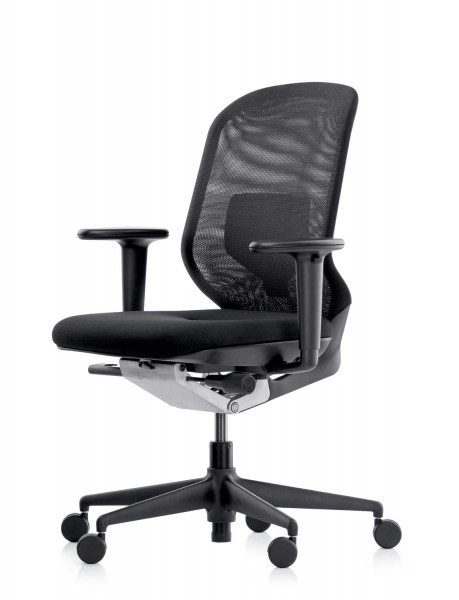Synchronous mechanism on the office chair
In order to prevent the lack of movement in the office, many innovations have been developed in recent years in the field of mobile seating and the mechanics of office swivel chairs. The mechanics are the heart of an office chair. Synchronous mechanism means that the backrest of the office chair adapts to your movement. The backrest and seat are flexibly coupled to each other and move in a fixed ratio to each other, for example 3:1 (9° backrest : 3° seat). When leaning back or forward, the backrest maintains an unchanged contact with your back and prevents the so-called "shirt-pulling effect". The synchronous mechanism allows the chair to follow your body movements forwards and backwards. When leaning back, the pressure on your intervertebral discs is reduced.
Standards for office chairs (DIN EN 1335-1)
The German Institute for Standards specifies the requirements for the safety and durability of office work chairs for use for eight hours a day by persons weighing 110 kg or less. With a synchronous mechanism, the backrest should be able to be tilted backwards by at least 15°. This corresponds to an angle of 105° to the horizontal. When leaning back, the seat tilt should be at least 6°. For the tilt ratio of the backrest to the seat surface, the ratio of 2:1 to 3:1 has become generally accepted. In addition, one would almost lie down and needed a neck rest and a special static of the office chair. Probably the relaxation effect would exceed the work result - but there's nothing to be said against leaning back occasionally: the body relaxes and good ideas come about almost by themselves.
Ergonomics in office furniture
The good old rocking chair and the cantilever chairs from the Dessau Bauhaus were probably the first ideas for mobile sitting - without any mechanics. Our ancestors sat in the office on unupholstered wooden chairs, which often caused them back problems. Today there are also office chairs with adjustable armrests, backrests or an adjustable seat. A lumbar support at belt height provides support and stability. All good office furniture should be ergonomically height-adjustable to adapt to the size of the user. If the office chair is not height-adjustable, the desk may be.
Other ergonomic concepts of office chairs
In contrast to the synchronous mechanism is the rocker mechanism, in which the backrest and the seat are permanently coupled, i.e. always in the same ratio to each other. A good example of a rocking mechanism is the rocking chair. With the 3D or Body Balance chair, there is permanent contact, the backrest moves flexibly and the chair follows every inclination, even sideways. Besides a swivel chair with or without castors, an ergonomic office stool may also be the right choice. It also takes up less space than a design chair or executive chair and is ideal for the small office or home office. Wilkhahn's Stitz also encourages movement and has a positive effect on the metabolism, the sense of balance and the muscular system. Anyone who does not want to sit or stand while working will receive the best support with the "Stand-Up" or Stitz by Wilkhahn.



